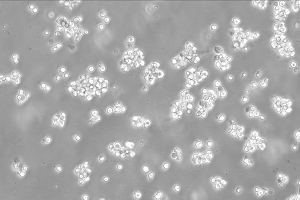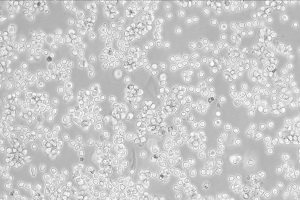Cell line profile Karpas 422
(ECACC catalogue no. 06101702)
Cell line history
Karpas 422 was established from a pleural effusion of a 73 year old woman diagnosed with B-cell non-Hodgkin lymphoma. Her cancer was intra-abdominal, and developed from B-cells in the lymphatic system leading to her death in 1986 (Dyer et al, 1990).
Key characteristics
Karpas 422 is a Human B cell non-Hodgkin lymphoma (NHL) cell line. Non-Hodgkin lymphomas are heterogeneous disorders characterised by the uncontrolled growth of lymphoid cells (Mounter and Leonard, 1999). Karpas 422 has been shown to have an abnormal karyotype. The cell line is typified by rounded or polygonal cells growing singularly or in small clusters in suspension. These cells have been found to be resistant to chemotherapy, making Karpas 422 a useful cell line for cancer research.
Applications
Karpas 422 is one of the most popular cell lines supplied by ECACC. Due to its resistance to chemotherapy, it is used as a model to validate methods of cancer treatment (Deggerdal et al, 1995) for example the “CHOP” strategy for NHL treatment,(so called after the chemicals used: Cyclophosphamide, Doxorubicin hydrochloride, Oncovin and Prednisolone). There have, however, been calls for new treatments to supersede the CHOP method (Fisher, 2000) and it is hoped that Karpas 422 could play a role in their development.
Culture tips
Karpas 422 should be cultured in RPMI 1640 medium supplemented with 2mM Glutamine and 20% Foetal Bovine Serum (FBS).The cultures should be maintained at a relatively high cell density, between 5-20 x 105 cells/ml at 37°C /5% CO2, splitting (1:2) fully saturated cultures every 2-4 days. When starting the ampoule from frozen, the cryo-protectant should be removed. This is achieved by adding the thawed cells to a conical centrifuge tube, carefully adding ~4ml media and taking a sample to perform a cell count. Centrifuging the cell suspension at 100-150 x g for 5 minutes, removing the medium and re-suspending the pellet at 5 x 105 cells/ml in fresh medium. Once the cell line has been established, the serum concentration can be reduced to 10%. These cells should be handled under laboratory containment level 2.
|
Related cell lines |
ECACC catalogue number |
Description |
|---|---|---|
|
Karpas – 25 |
Human acute plasma cell leukaemia |
|
|
Karpas – 929 |
Human multiple myeloma |
|
|
Karpas – 1106P |
Human B-Cell Non-Hodgkin's Lymphoma |
|
|
Karpas – 1718 |
Human splenic lymphoma |
|
|
Karpas – 231 |
Human B-cell leukaemia |
|
|
Karpas – 299 |
Human Non-Hodgkin’s Ki-positive Large Cell Lymphoma |
|
|
Karpas – 384 |
Human T-cell non-Hodgkin lymphoma |
|
|
Karpas – 417 |
Human myeloma |
|
|
Karpas – 45 |
Human T-cell Leukaemia |
Key references
-
Dyer, M.J., et al., A new human B-cell non-Hodgkin's lymphoma cell line (Karpas 422) exhibiting both t (14;18) and t(4;11) chromosomal translocations. Blood, 1990. 75(3): p. 709-14.
-
Mounter, P.J. and A.L. Lennard, Management of non-Hodgkin's lymphomas. Postgraduate Medical Journal, 1999. 75(879): p. 2.
-
Deggerdal, A.H., et al., Semiquantitative polymerase chain reaction for t(14;18) in follicular lymphomas: a colorimetric approach. Lab Invest, 1995. 72(4): p. 411-8.
-
Fisher, R.I., Diffuse large-cell lymphoma. Annals of Oncology, 2000. 11(suppl_1): p. S29-S33.


